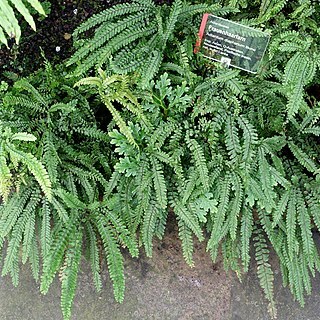Rhizome erect, c. 2 mm diam.; scales concolorous, golden brown, with entire margins and prominent apical seta. Roots with ovoid proliferous tubers to c. 1.5 mm long. Fronds tufted, to 36 cm long. Stipe to 18 cm long, smooth adaxially, scabrous abaxially. Lamina 1-pinnate, or 2 (3)-pinnate at the base and 1-pinnate above, subpedate, hastate or triangular, 5–17 cm long, 2–13 cm wide, membranous; rachis flexuose, glossy, glabrous. Basal pinnae, when present, 1 or 2 (rarely more), narrowly triangular, 1-or 2-pinnate. Pinnules dimidiate, rectangular to subtrapeziform, becoming cuneate-flabellate in apical segments, sparsely to very sparsely setose; distal margins shallowly lobed, denticulate when sterile; veins dark brown near stalk, otherwise pale. Sori 1–10 along distal margins, usually 1 per lobe; soral flaps round to subreniform, setose (rarely glabrous), deeply immersed in the lobe. Spores ?64 per sporangium, yellow; perine scabrous; largest diam. (25.6–) 33.9 (–51.9) µm. See also Green (1994: 563).
Rhizome short, ascending, clad in dark brown linear-subulate attenuate paleae, c. 3-4 mm. long, us. with small tuber-like expansions; stipites tufted to clustered. Stipes slender to filiform, very dark brown, glab. except at paleate base. Rhachis filiform, glab., ± flexuous, bearing simple pinnae or 1-4 secondary pinnae in lower portion. Lamina rather dark green, delicate, flaccid. bearing sparse minute stiff hairs, to glab., narrow-to ovate-oblong. Lateral pinnae (1-4, if present) 4-15 × 1-2 cm., stalked, narrow-oblong. Terminal or sole pinna up to 13 × 2.5 cm., oblong to ovate-oblong. Pinnules dimidiate-oblong, stalked, sparingly setulose, up to 15 × 8 mm.; lower margin entire, straight or slightly curved; upper with numerous lobes or teeth. Sporangia in sinuses of lobes, protected by reflexed pale to dark brown, lunulate margin; 4-8 groups per pinnule.
Rhizomes short, erect, scaly; rootlets bearing small tubers. Stipes and rachises glabrous except at very base. Laminae either 1-pinnate with 5-16 undivided pinnae on each side of rachis, or 2-pinnate with 1-(2) pairs of primary pinnae bearing secondary pinnae and a terminal portion with 12-25 undivided primary pinnae on each side; 1-pinnate fronds 5-10 × 1.5-3 cm, narrowly triangular; 2-pinnate fronds 8-20 × 4-18 cm, 3-fid. Ultimate pinnules ± oblong or parallelogrammoid, tending to curve basiscopically, 5-20 × 4-10 mm; stalk attached at proximal corner; upper and outer margins regularly lobed, inner and lower margins entire; upper surface glabrous, lower hairy or glabrous, both dark green. Indusia ± reniform with prominent sinuses, hairy or glabrous, up to 8 per pinnule on upper and outer margins.

